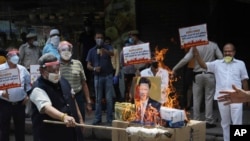Photos posted on Chinese social media allegedly show Indian soldiers captured by Chinese People Liberation Army troops following border clashes in the western Himalayas in June 2020.
The bloody hand-to-hand clashes, which left dozens dead, occurred in the Galwan River Valley, a disputed territory in eastern Kashmir. The fighting took place in freezing temperatures at an elevation of 4,300 meters.
On November 6, Shen Shiwei, international news editor for China’s state-run Global Television Network (CGTN), posted some of those photographs to Twitter.
“New pictures of last June’s #Galwan clash emerged on social media, showing surrendered Indian soldiers captured by Chinese PLA,” he wrote.
“Indian soldiers violated newly reached consensus and launched provocative attacks against Chinese personnel, leading to serious physical conflicts.”
It remains unclear whether the photographs are authentic and who provoked the bloody conflict. But efforts to debunk them as staged have fallen short.
In response to Shin’s tweet, some Indian social media users claimed the photos are phony.
For example, retired Major General Harsha Kakar tweeted: “These are fake & morphed pictures. Indian soldiers do not have long hair. These r not soldiers but locals whom China has clicked attempting infowarfare after it faced a crushing boot in Tawang. It is desperate to hide its 111 casualties in Galwan. Improve quality of fake pictures.”
Others have also claimed the photos were staged or digitally manipulated, with some even claiming, without evidence, the men pictured are actually Pakistani.
Many of those who have commented claimed the men pictured in the photographs violated Indian Army grooming protocols. They assert that Indian soldiers are not allowed to grow their hair long, have beards or wear pajamas.
Some Indian media have repeated those claims.
However, the pro-Indian military website Defencelover has detailed exceptions to the Indian military’s grooming protocol. For example, members of the Sikh faith are allowed to keep beards and grow out their hair.
Moreover, special forces, particularly those serving in Kashmir, where the border conflict took place, are permitted to grow out their hair and sport beards to better blend in with the local population and help stay warm.
Regular soldiers on active duty are also sometimes exempt from facial hair regulations if their assignment hinders access to appropriate grooming facilities
Some commenting on social media also claimed the men in one photograph could not be Indian soldiers because one of them was allegedly wearing a shalwar — loose pajama-like trousers — and a kameez — a long shirt.
In that photo, however, the legs of the individual in question are largely obscured by the boots of another soldier. What is described as the bottom of a kameez actually appears to be the pocket of his combat pants. Every other person in the photograph who can be seen clearly is wearing combat pants.
The apparently mismatching uniforms do not necessarily indicate the photo was staged.
Although the Indian Army’s 16th Bihar Regiment played an outsized role in the fighting and took most of the casualties, other regiments were also involved, as were members of the Indo-Tibetan Border Police (ITBP), which operates under the Ministry of Home Affairs and not the Ministry of Defense.
The captives were also likely of different ranks, yet another factor that could account for the differences in jacket and combat fatigues.
For example, popular comedian Kapil Sharma was photographed together with Indian soldiers when he visited the Bum La Pass on the Indian-Chinese border in November 2019.
The soldiers he was photographed with were clearly wearing different jackets, hats, and combat trousers, with varying camouflage patterns.
Similarly, another social media user noted that one of the putatively captured Indian soldiers was pictured in one of the photos wearing a sweater, proving he was not in the Indian military.
Problem is, India’s National Defense Academy notes that a sweater or a jacket can be worn over the combat uniform.
India’s Foreign Ministry did not respond to Polygraph.info's request for comment.
This is not the first time such images have been released.
In October, the Chinese Communist Party’s (CCP) Global Times newspaper released a video purportedly showing PLA troops escorting captured Indian soldiers in blindfolds.
India’s opposition Congress Party called out the government of Prime Minister Narendra Modi and the ruling Bharatiya Janata Party for failing to publicly address the video’s authenticity.
In any case, India has not denied that it took casualties in the border clashes or that Indian soldiers were captured.
India has conceded 20 deaths from the melee, while China only confirmed four. Indian and other sources have claimed that China suffered as many, if not more deaths in the fighting.
Those were the first deaths along the Line of Actual Control (LAC) — which separates Chinese from Indian territory — since 1975.
India has also conceded that some of its soldiers were temporarily taken captive during the confrontation. While India also claims it captured Chinese troops, China has not commented on the point.
Others have questioned why the photos were released more than a year after the clashes. They arrived on the eve of a key meeting of the CCP’s Central Committee, which observers believe will allow a historic, third five-year term for President Xi Jingping.
It also remains unclear which side sparked the border clash.
As Polygraph.info previously reported, the U.S. China Economic and Security Review Commission said in a 2020 report to the U.S. Congress that it had found evidence suggesting Beijing planned the massive June 2020 brawl involving Chinese and Indian troops along the border.
The U.S. commission said satellite images showed a large Chinese troop buildup in the Galwan Valley a week before the melee, “including potentially 1,000 PLA [People’s Liberation Army] soldiers.”
That coincided with a build-up of infrastructure to support Chinese troop in the region. Although the U.S. commission pinned the blame on China, it did not say who initiated the melee.







